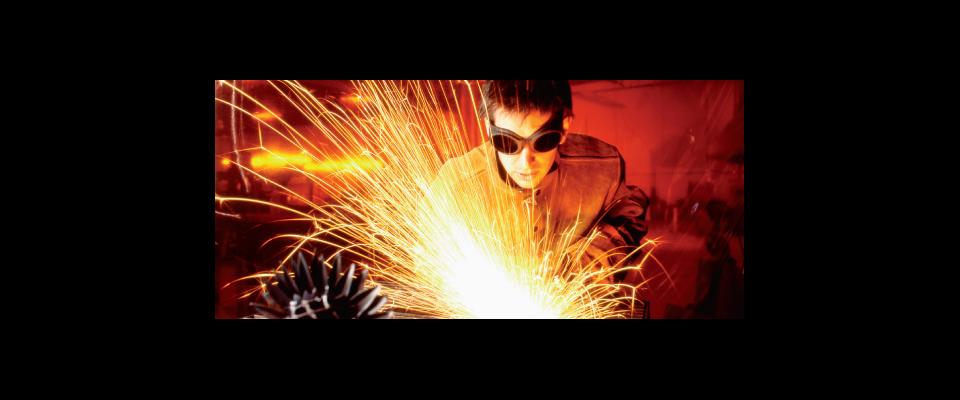The Crucible’s promotional tactics are hard to ignore.
Forgive the Crucible its flamboyance. That 30-foot plume of flame jetting from the roof of a tricked-out 1960 fire engine is designed to get your attention. And it works; the blast accompanying the ignition of 24 gallons of propane is loud enough to startle the jaded and hot enough to warm the faces of onlookers perched a safe distance away. The flame is followed by a smoke ring reaching 75 feet into the air.
Once the air clears, the Crucible has hooked its audience. Then begins its real mission: introducing members of the public to the curious crafts it hopes to one day teach them. “It’s a way of bringing people in that’s unexpected and also very dramatic,” said Steven Young, executive director of the West Oakland nonprofit organization. “We’re introducing a large group of people to industrial arts, and we’re calling attention to our classes.”
The restored fire engine, otherwise known as the Educational Response Vehicle, holds an arsenal of tools and equipment for blacksmithing, arc welding, torch cutting, and glass flameworking. The ERV can support simultaneous demonstrations of all four techniques: heating steel in a 1,500-degree on-board forge (so well insulated that fenders a few feet away remain cool); cutting metal with the aid of an oxy-acetylene torch; and melting glass with an oxy-propane bench torch. Spectators are protected from sparks and ultraviolet light by red or amber PVC screens. For many onlookers, it’s the most intimate they’ve ever been with the industrial arts.
Anywhere the ERV goes, copies of the Crucible’s pocket-size catalog follow. Last year the organization offered 175 classes in 17 different departments from Ceramics to Welding. Many are taught by Cal alumni, including Ed Kirshner ’66, MCP ’71 (plasma sculpture), Roger Carr, Ph.D. ’81 (metalworking), and Lara Hopwood ’95 (fire performance). Beginning courses with titles such as Introduction to Neon, Build Your Own Propane Forge, and Glass Fusing and Slumping I are designed to be considerably less intimidating than they sound, and lack prerequisites. Classes range in duration from one to ten sessions and in price from below $100 to well over $500.
But there’s only one way to truly know the Crucible, and that’s to feel its buzzing, humming, glowing heart in a 56,000-square-foot warehouse near West Oakland BART. On a Thursday afternoon in mid-September, Introduction to Blacksmithing instructor Chris Niemer shouted instructions over a pair of 2,500-degree gas-fired forges roaring in the center of the room. A thermometer on the wall read 106 ºF. Pulled from the forge, luminescent orange steel rods were bent like taffy with the firm clang of a hammer.
Above the din, a shrill buzz bled through the walls from the grinding room next door, where a solitary metalworker bore down on a flat metal frame, sparks spraying. Just outside the smithy, another instructor demonstrated the fundamentals of tungsten inert gas welding to a group of new acolytes donning metal masks, a pointed yellow flame emitting from the gun couched in his palm. And at the other end of the building, six men stood in a semicircle watching casually as sporadic fountains of flame erupted 20 feet into the air from a small red cylinder before them.
The point of all this, Young explained a week earlier, is to return both art and manufacturing to the reach of ordinary people—a democratization of sorts. Lectures are limited and hands-on learning is maximized. The industrial arts are rooted in the notion of producing objects—a wooden chair, a leather bag, a neon sign, a metal spoon—that can be useful, artistic, or both. To Young, it’s an empowering philosophy.
“Once you learn how to manipulate and change materials in your hands, it teaches you that you have the opportunity to change more than just metal and glass,” he said. “You have what it takes to make change in your own environment and your own space.… We are really teaching people that they can influence their surroundings.”
That message is especially crucial to the Crucible’s younger students. Last year, the organization enrolled 541 children as young as 8 in age-appropriate classes. Nearly a third of the students received scholarships from the Crucible’s own budget and through outside donors. The organization reached another 3,500 local and disadvantaged youth through outreach events, monthly bike programs, field trips, summer camps, community workshops, and internships.
Community outreach and youth programs have recently expanded to fill in the “continuum of lifelong learning” that is one of the primary goals of education director Kristy Alfieri ’97. The Crucible’s adult program hasn’t been so fortunate.
Enrollment has dipped along with the economy. The organization’s annual budget, 65 percent of which comes from class tuition, workshops, and artist rental studios (the rest is donations and grants), has suffered accordingly. In place of growing at its pre-recession rate, the Crucible has opted to improve existing programs and diversify its income opportunities, Young said.
The decline in adult enrollment—from a high of 1,910 in 2009 to 1,722 the following year—surely derives from the fact that for most students, a Crucible class is a luxury item, and a costly one at that, rather than a professional development tool. The organization has consciously shied away from developing credential programs, even though its existing faculty, including professionals with decades of experience, would likely be up to the task.
“It’s not like university or community college courses,” said welding and metal fabrication instructor Carr, who earned a physics Ph.D. from Berkeley and has launched a second career in art. “We don’t teach at the level of vocational skill.… It’s all oriented toward personal satisfaction.”
The Crucible’s do-it-yourself ethos and messages of self-reliance and human-scale production thus resonate with backers of backyard gardening, urban homesteading, and shop-local campaigns. The woodworking department alone could teach these folks to build their own kitchen table, chicken coop, or ukulele. And the organization’s emphasis on creativity and mechanical tinkering overlaps with the so-called maker community, popularized by Make magazine and its Maker Faire, first held in 2006 in San Mateo and now expanded to other cities across the world.
The Crucible’s own performances—the popular Fire Operas, Fire Ballets, Fire Circus, and discontinued Fire Arts Festival—serve as in-house showcases, fundraising opportunities, and attention-grabbers for the next round of students. In its January world premiere, Machine: A Fire Opera pairs opera and rock singers with blacksmiths and glass blowers, plus a live molten metal pour. And those fire-breathers onstage exhaling radiant orange blazes of ultrapure lamp oil? They learned at the Crucible, too.



















